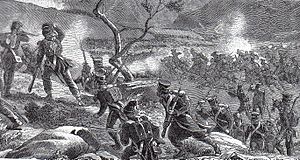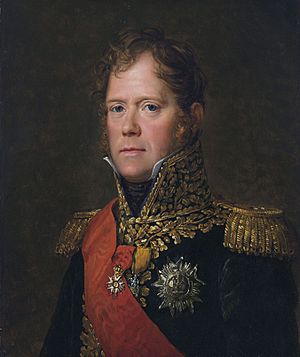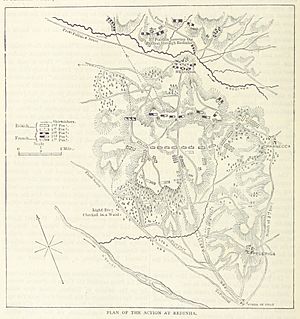Battle of Redinha facts for kids
Quick facts for kids Battle of Redinha |
|||||
|---|---|---|---|---|---|
| Part of the Peninsular War | |||||
 Battle of Redinha, 12 March 1811, by Henri Félix Emmanuel Philippoteaux. |
|||||
|
|||||
| Belligerents | |||||
| Commanders and leaders | |||||
| Strength | |||||
| 7,000 6 guns |
25,000 12 guns |
||||
| Casualties and losses | |||||
| 150 to 229 killed, wounded or missing | 205 to 1,800 killed, wounded or missing | ||||
The Battle of Redinha was a small but important fight. It happened on March 12, 1811, in Portugal. This battle was part of the Peninsular War. It involved a French army division led by Michel Ney, who was a Marshal. They fought against a much larger Anglo-Portuguese Army led by Wellington.
Marshal Ney had about 7,000 soldiers. Wellington had around 25,000. Ney's goal was to delay Wellington's army. This type of fight is called a rearguard action. It helps the main army retreat safely. Ney successfully slowed down the Allies for a whole day. This gave the main French army more time to get away.
Redinha was the second successful rearguard action during the French retreat. The French were leaving the Lines of Torres Vedras. These were strong defenses in Portugal. Ney had already held off the British at Pombal the day before. After that, he moved his rearguard to Redinha.
Contents
Why the Battle Happened
By early 1811, the French army in Portugal was in trouble. They had been stuck at the Lines of Torres Vedras for six months. Their soldiers were starving and losing hope. Their commander, André Masséna, decided it was time to leave Portugal.
Masséna planned to move his army between March 4 and 6. He wanted to reach Coimbra. From there, they could cross the Mondego River and find safety. The French hoped to find more food as they moved back.
Masséna knew the British and Portuguese would notice his plans. So, he took steps to protect his army. He sent Marshal Ney with two divisions and cavalry. Ney's job was to protect the main retreat route. Other French generals also moved their troops to support the retreat.
Wellington's Moves
The Allied army, led by Wellington, waited a few days. They wanted to be sure of the French plans. Wellington was careful. He didn't want to risk his army unless he was sure of winning. He knew Masséna was a famous commander.
On March 6, Wellington began to follow the French. He moved slowly and carefully. Meanwhile, some Portuguese soldiers had already taken control of areas along the Mondego River. This made it harder for the French to cross.
On March 11, French scouts found the Mondego River was flooded. It was impossible to cross. Also, Portuguese soldiers held Coimbra. The next day, they found a place to build bridges, but it would take time.
The Fight at Pombal
Wellington's army first met the French at Pombal. This was on March 11. Marshal Ney first let the British enter the village. Then, he suddenly attacked with three battalions. The French pushed the British out of the town. Some British soldiers were even forced into the river.
The French then set Pombal on fire. This stopped the Allies from chasing them for a while. This gave Masséna more time. But the French still missed their chance to take Coimbra.
The Battle of Redinha
Starting the Fight
Marshal Ney set up his soldiers about 3 kilometers south of Redinha. He had one division, led by General Mermet. He also had cavalry and 8 cannons. Another division, led by General Marchand, was further north. They were across the Ancos River, near Redinha village. A narrow bridge connected these two French groups.
Wellington's army arrived bit by bit. He was not sure how strong the French force was. So, he moved carefully. His first three divisions stopped and got ready to face Mermet's soldiers. The Light Division was on the west. Pack's Portuguese brigade was in the middle. Picton's 3rd Division was on the east.
When Cole's 4th Division arrived, the Allies had many more soldiers. They began their attack around 2 PM.
Fighting at Redinha
Wellington sent his 3rd and Light Divisions to attack the sides of Mermet's position. The soldiers in the middle moved forward slowly. They were hit by French cannon fire. There was heavy fighting in the center. There were also small fights on the sides, especially in a forest.
Eventually, the French sides were pushed back. To avoid being surrounded, Ney quickly pulled Mermet's soldiers back. They moved to their second position across the Ancos River, where Marchand's division was waiting. As the French crossed the river, they got stuck on the bridge. British soldiers from the Light Division shot at them from close range. This caused many French losses.
The Anglo-Portuguese troops took some time to cross the river. Then they got ready for another attack. They used the same plan. The 3rd and Light Divisions attacked the sides. Cole's 4th Division and Pack's Portuguese attacked the center.
Just like before, Ney waited until the last moment. Then he pulled his troops back again. It was getting dark. The Allied soldiers chased them for a while. Then Ney suddenly turned two battalions around. They fired heavily at the Anglo-Portuguese. After that, the French retreated in an organized way to the village of Condeixa.
After the Battle
Ney's two stands at Pombal and Redinha were very successful. He delayed the Allies for a whole day. Wellington's army only moved about 16 kilometers in 24 hours.
The next day, March 13, Wellington met Ney's rearguard again at Condeixa. This time, Picton's Division tried to cut off Ney's soldiers. This forced Ney to retreat quickly without much fighting.
Historians have different ideas about how many soldiers were lost. Some say the French lost about 229 men. Most of these were from Mermet's division. Allied losses were around 205 men, mainly from the 3rd and Light Divisions. Other sources say the British lost around 1,800 men, while the French lost only 150.
Some people at the time criticized Wellington for being too careful. But Wellington knew he was facing a large French army. He also knew other French groups were nearby. He didn't want to risk losing many soldiers in a small fight. He believed it was better to delay a few hours than to have a costly battle.
Many British commanders praised Ney for his excellent work. He protected the French army's retreat. He held Wellington back for a full day. This gave Masséna the time he needed to cross the Mondego River.
However, Masséna did not use this time well. He did not try to make a surprise attack on Coimbra. Even though the Portuguese soldiers there were weak, Masséna did not attack. By the end of March 12, the French were still south of the river. They were in danger of being trapped by Wellington.
The only other way for Masséna was to retreat east towards Spain. The road led from Condeixa. Since the British were close to that village, Masséna began his long and difficult retreat back to Spain on March 13. This marked the complete failure of his big invasion of Portugal.
The next battles would be at Condeixa, then Casal de Novo, and finally, Foz de Arouce.
|



